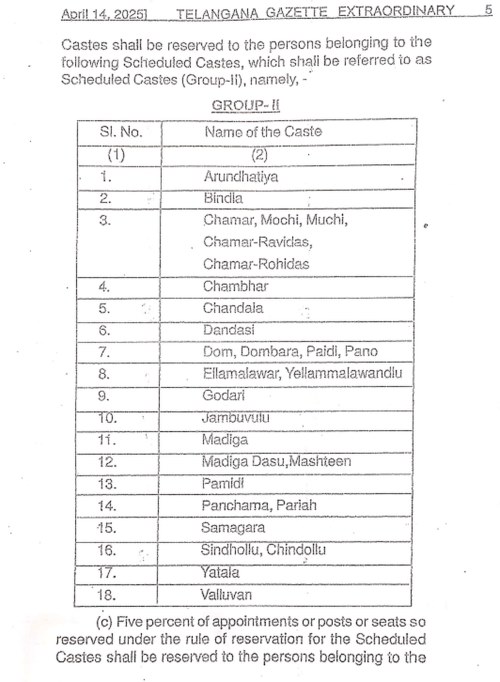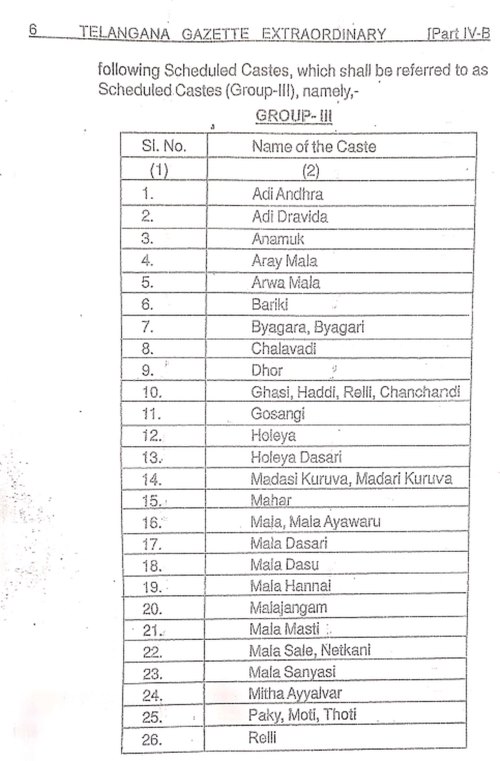On April 14, 2025, Dr. BR Ambedkar's Jayanti, the government of Telangana officially started a new system for how people from Scheduled Castes (SCs) get support, like jobs and school spots. This new system, called the Scheduled Caste (SC) Categorisation of Reservations Act 2025, is something many people have wanted for a long time. In this article, we will explore how many SC groups were categorised and mainly who will get more benefits.
Telangana is the first state in India to implement the revolutionary decision of #SCSubCategorisation
— Revanth Reddy (@revanth_anumula) April 14, 2025
We are all proud to have made history.
On the highly auspicious day of the birth anniversary of Bharat Ratna, Babasaheb
Dr. B. R. Ambedkar, the #Telangana State government…
In the Scheduled Caste (SC) Categorisation of Reservations Act 2025, there are 56 different groups within the larger SC community in Telangana. The government has now divided these 56 groups into three smaller groups. This is because people naturally want things to be fair. The government realised that some of these smaller groups weren't getting as much help as others, even though they are all considered SC. So, they made this change to make sure everyone gets a fair chance, so the State Governor gave consent for the bill, which was passed by the State Legislature last month
This new way of grouping people will help the government decide who gets reserved spots in schools, jobs, and even in politics in the future. It's a big step for Telangana in trying to make things more equal for everyone, especially for those groups within the SC community who haven't benefitted as much in the past.
Which Indian state became the first to implement the SC sub-categorisation?
Telangana became the first Indian state for implementing the SC sub-categorisation. The Telangana government took into consideration the content of the Supreme Court’s verdicts done in August 2024 under the seven-judge constitution bench of the Supreme Court headed by former Chief Justice of India D.Y.Chandrachud in which it was notified in the President's list with the objective to extend the “Creamy Layer principle” to Schedule Caste and Schedule Tribes.
SCCategorisation #Telangana#SocialJustice #CasteSurvey pic.twitter.com/4TRoE8iRL4
— Revanth Reddy (@revanth_anumula) April 14, 2025
How many categorisations were done in the SC sub-categorisation?
The Telangana government has considered an accounting of data looking at the social, economic, educational, employment and political status of the Schedule Caste communities; this has been done in three groups for implementations of the rule of reservation. As per the data, 15 subcastes are categorised as most backward and have been classified as Group I with 1% reservations.
What are the categories done in Scheduled Caste?



Source: The Hindu
According to the notification, Schedule Caste in the state will be divided into three categories: Group I, II and III
| Group | Number of Sub-Castes | Reservation Percentage | Explanation |
| Group I | 15 | 1% | These are the most backward among the Scheduled Castes (SCs) and constitute just 0.5% of the population. The government provided 1% reservation to provide them with educational and employment opportunities. |
| Group II | 18 | 9% | These sub-castes received marginal benefits and are placed under this group with a 9% reservation. |
| Group III | 26 | 5% | These sub-castes were relatively better placed in terms of opportunities and have a 5% reservation. |
Who will get a benefit from SC sub-categorisation?
As per Telangana CM Revanth Reddy, he mentioned that if the number of people who belong to SCs increases in the 2026 count, the number of reserved spots will increase.
He also said that from now on, when the government hires for jobs, they will use this new way of sorting SC communities. Minister Reddy encouraged young people from these communities to take advantage of these opportunities. However, he clarified that this new sorting system won't apply to job openings that have already been announced.
The Health Minister, C Damodar Rajanarsimha, who also helped lead the group that decided on these categories, explained that most of the smaller groups within the SCs (33 out of 59) are staying in the same category as before. Only a small number of these smaller groups (26, which is about 3.43% of the total SC population) have been moved to different categories.
Conclusion
Telangana's new SC categorisation, a long-awaited move launched on Ambedkar's birthday, reflects a basic human desire for fairness. Recognising uneven benefits among SC groups, this re-grouping aims to give everyone a more equal shot at opportunities, making Telangana a pioneer in striving for true equity.
Comments
All Comments (0)
Join the conversation